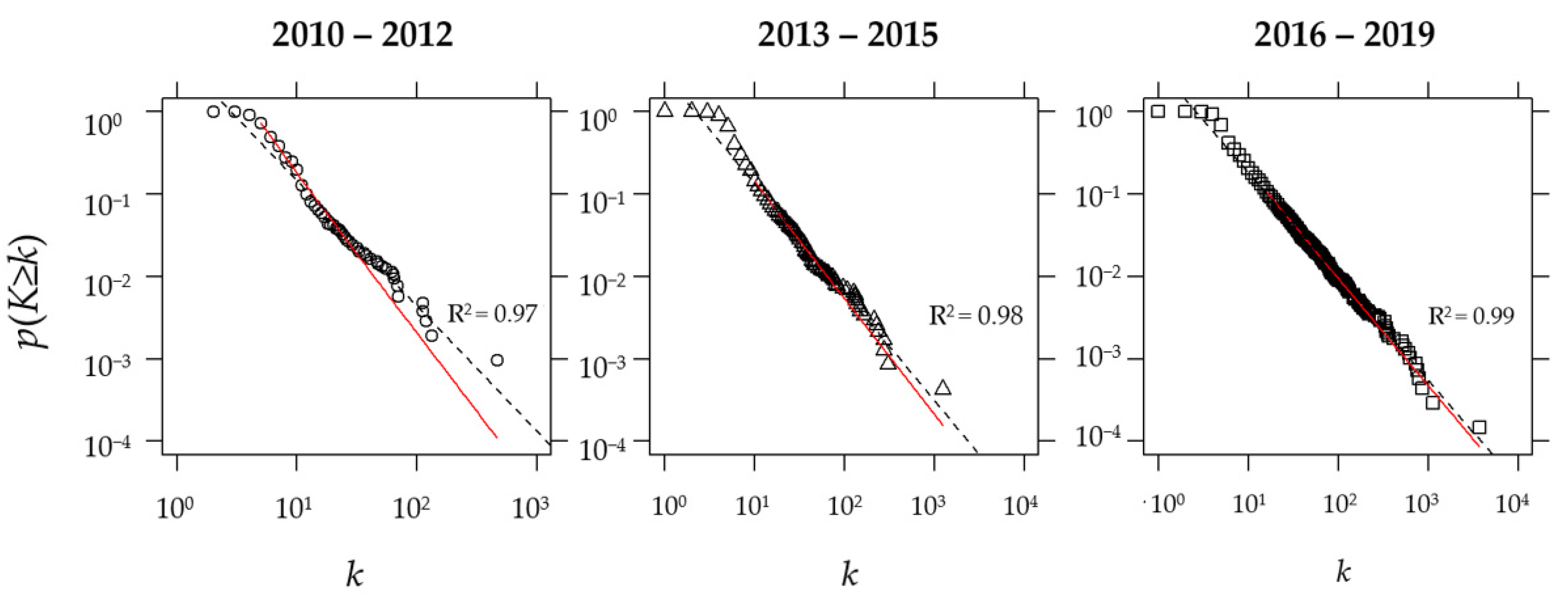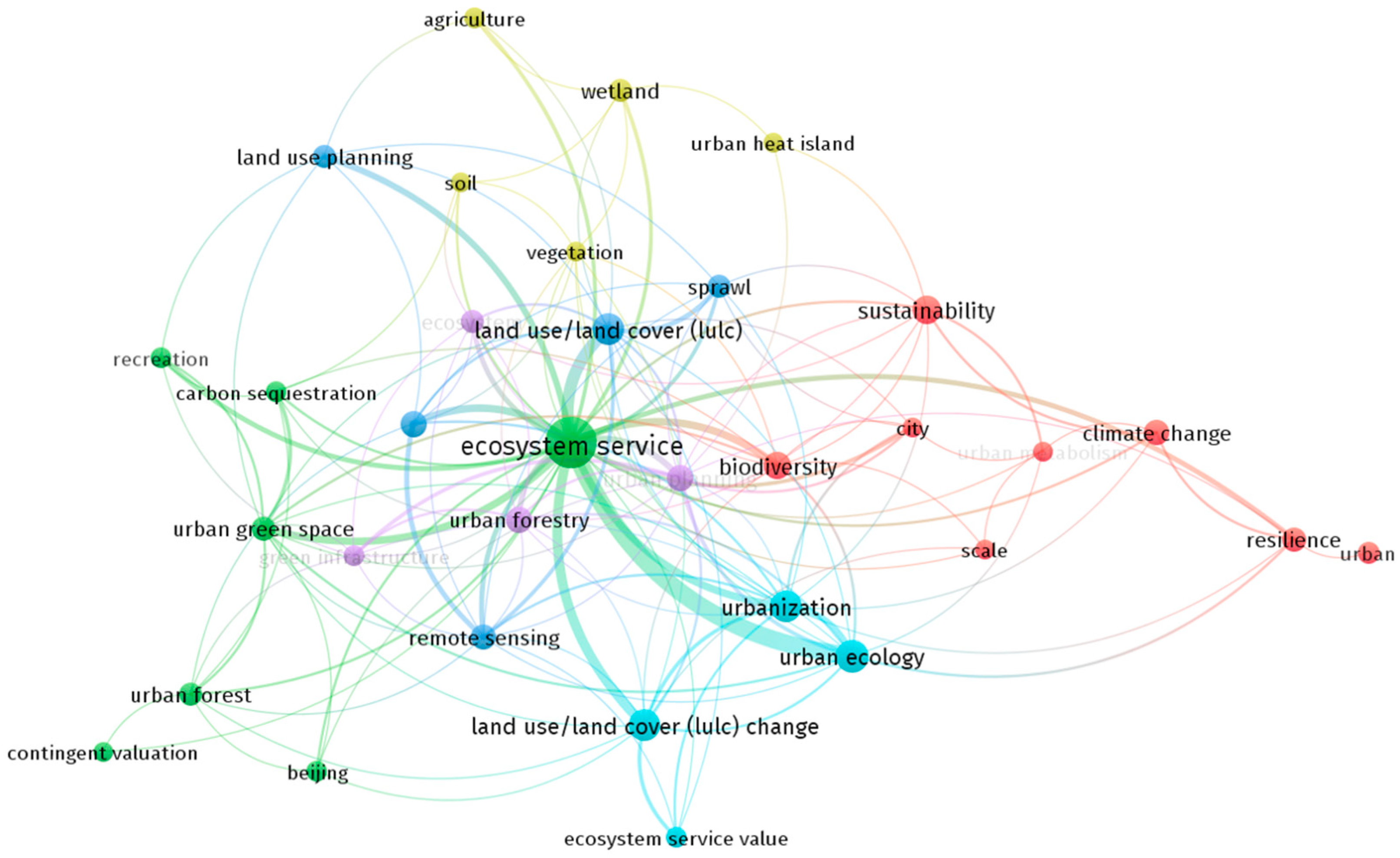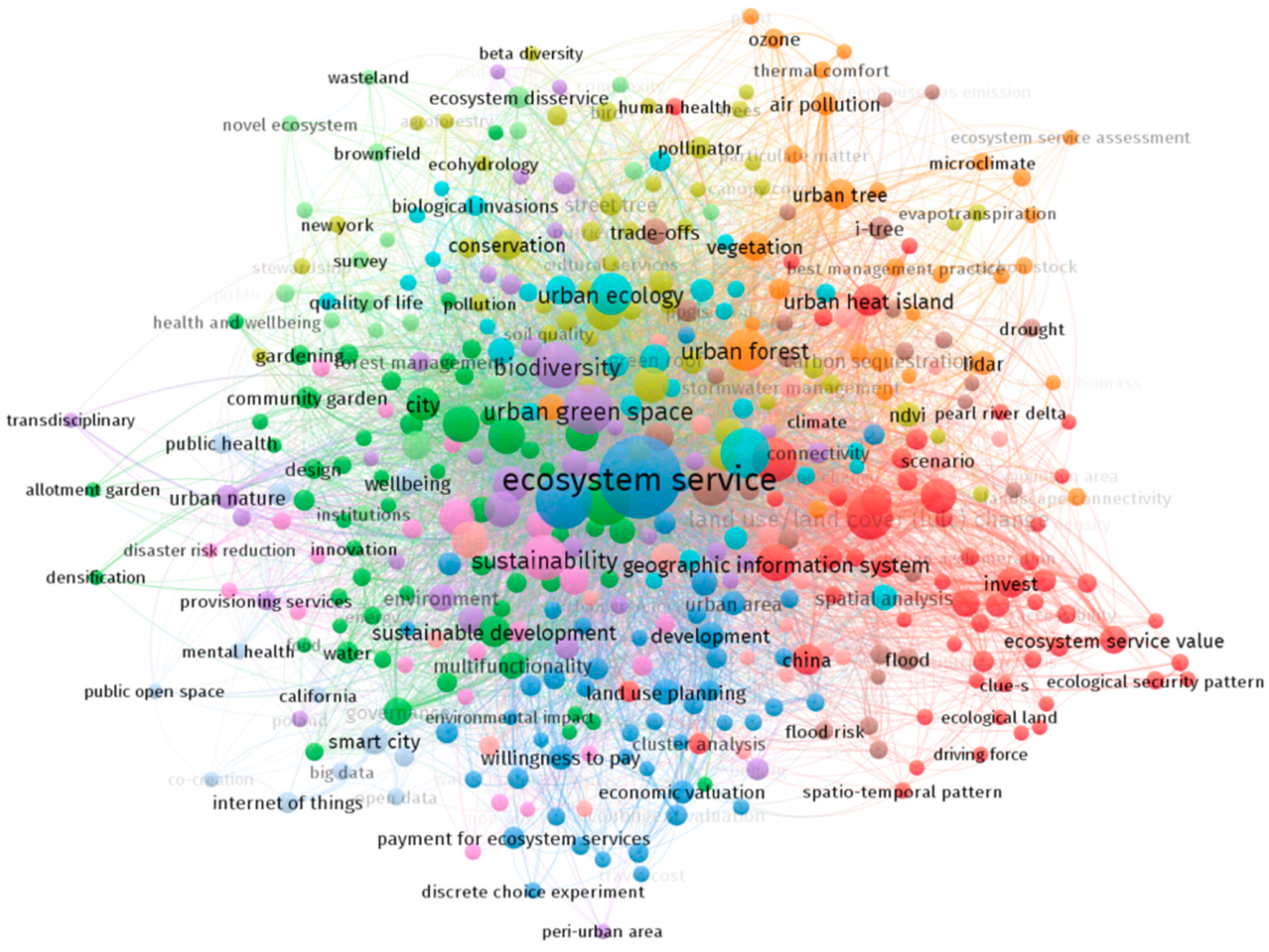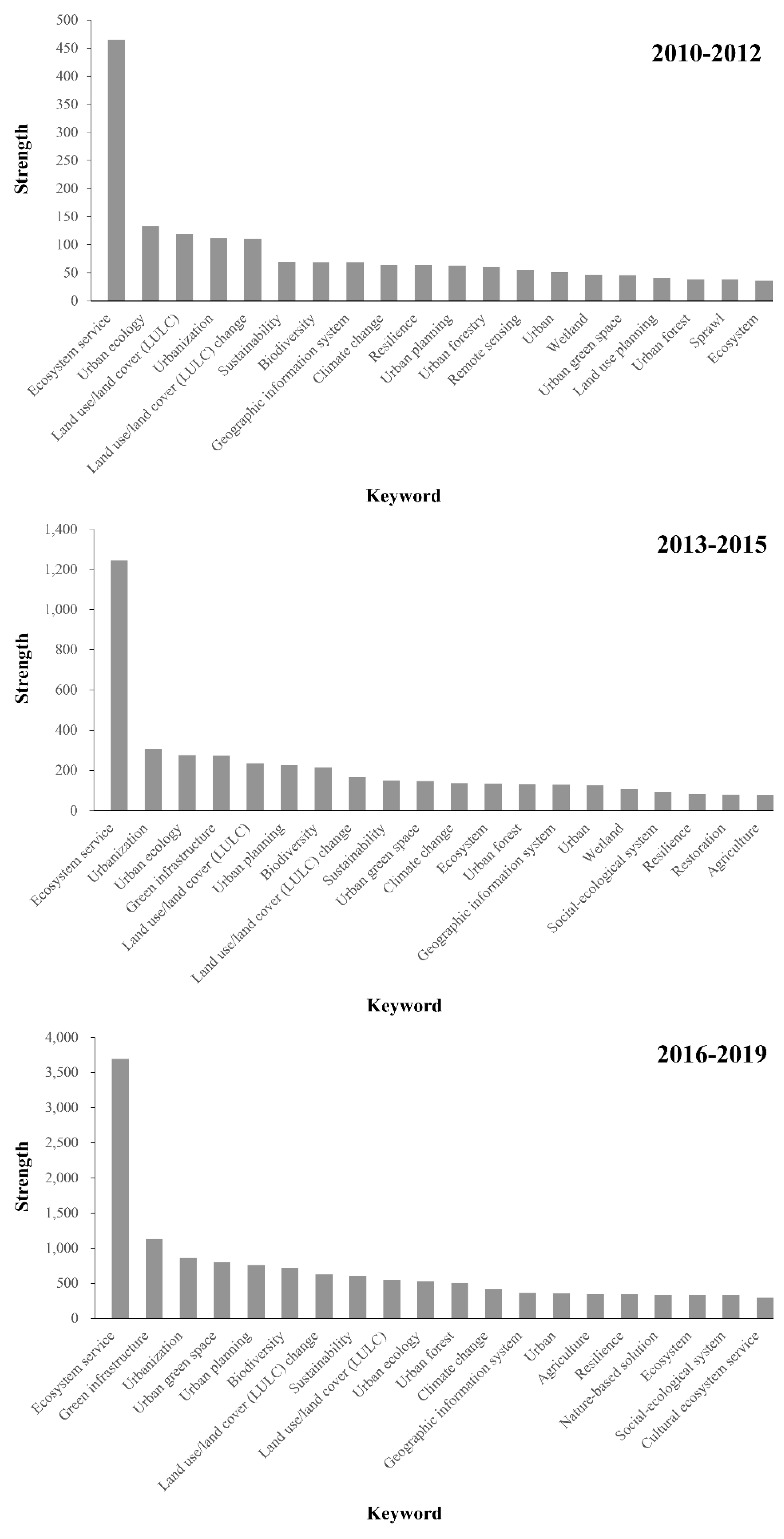Urban Ecosystem Services: A Review of the Knowledge Components and Evolution in the 2010s
Abstract
1. Introduction
2. Materials and Methods
2.1. Materials
2.2. Methods
Application of Keyword Co-Occurrence Network Metrics
3. Results
3.1. UES Literature Macro Trends
3.2. Additional Analyses (Micro-Level Knowledge Trends)
4. Discussion and Conclusions
Limitations and Future Research Directions
Author Contributions
Funding
Acknowledgments
Conflicts of Interest
References
- Elmqvist, T.; Fragkias, M.; Goodness, J.; Güneralp, B.; Marcotullio, P.J.; McDonald, R.I.; Parnell, S.; Schewenius, M.; Sendstad, M.; Seto, K.C.; et al. Urbanization, Biodiversity and Ecosystem Services: Challenges and Opportunities: A Global Assessment; Springer Nature: Dordrecht, The Netherlands, 2013; p. 755. [Google Scholar]
- Grimm, N.B.; Faeth, S.H.; Golubiewski, N.E.; Redman, C.L.; Wu, J.; Bai, X.; Briggs, J.M. Global change and the ecology of cities. Science 2008, 319, 756–760. [Google Scholar] [CrossRef] [PubMed]
- Gómez-Baggethun, E.; Gren, Å.; Barton, D.N.; Langemeyer, J.; McPhearson, T.; O’Farrell, P.; Andersson, E.; Hamstead, Z.; Kremer, P. Urban Ecosystem Services. In Urbanization, Biodiversity and Ecosystem Services: Challenges and Opportunities: A Global Assessment; Elmqvist, T., Fragkias, M., Goodness, J., Güneralp, B., Marcotullio, P.J., McDonald, R.I., Parnell, S., Schewenius, M., Sendstad, M., Seto, K.C., et al., Eds.; Springer: Dordrecht, The Netherlands, 2013; pp. 175–251. [Google Scholar]
- Seto, K.C.; Fragkias, M.; Güneralp, B.; Reilly, M.K. A meta-analysis of global urban land expansion. PLoS ONE 2011, 6, e23777. [Google Scholar] [CrossRef] [PubMed]
- Rockström, J.; Steffen, W.; Noone, K.; Persson, Å.; Chapin, F.S.; Lambin, E.F.; Lenton, T.M.; Scheffer, M.; Folke, C.; Schellnhuber, H.J. A safe operating space for humanity. Nature 2009, 461, 472–475. [Google Scholar] [CrossRef] [PubMed]
- Elmqvist, T.; Andersson, E.; Frantzeskaki, N.; McPhearson, T.; Olsson, P.; Gaffney, O.; Takeuchi, K.; Folke, C. Sustainability and resilience for transformation in the urban century. Nat. Sustain. 2019, 2, 267–273. [Google Scholar] [CrossRef]
- Goddard, M.A.; Dougill, A.J.; Benton, T.G. Scaling up from gardens: Biodiversity conservation in urban environments. Trends Ecol. Evol. 2010, 25, 90–98. [Google Scholar] [CrossRef] [PubMed]
- Andersson, E.; Barthel, S.; Borgström, S.; Colding, J.; Elmqvist, T.; Folke, C.; Gren, Å. Reconnecting Cities to the Biosphere: Stewardship of Green Infrastructure and Urban Ecosystem Services. AMBIO 2014, 43, 445–453. [Google Scholar] [CrossRef]
- TEEB. The Economics of Ecosystems and Biodiversity: Mainstreaming the Economics of Nature: A Synthesis of the Approach, Conclusions and Recommendations of TEEB. 2010. Available online: www.teebweb.org (accessed on 6 July 2020).
- Haase, D.; Frantzeskaki, N.; Elmqvist, T. Ecosystem Services in Urban Landscapes: Practical Applications and Governance Implications. AMBIO 2014, 43, 407–412. [Google Scholar] [CrossRef]
- Haase, D.; Larondelle, N.; Andersson, E.; Artmann, M.; Borgström, S.; Breuste, J.; Gomez-Baggethun, E.; Gren, Å.; Hamstead, Z.; Hansen, R.; et al. A Quantitative Review of Urban Ecosystem Service Assessments: Concepts, Models, and Implementation. AMBIO 2014, 43, 413–433. [Google Scholar] [CrossRef]
- Kremer, P.; Hamstead, Z.; Haase, D.; McPhearson, T.; Frantzeskaki, N.; Andersson, E.; Kabisch, N.; Larondelle, N.; Rall, E.L.; Voigt, A. Key insights for the future of urban ecosystem services research. Ecol. Soc. 2016, 21, 29. [Google Scholar] [CrossRef]
- Luederitz, C.; Brink, E.; Gralla, F.; Hermelingmeier, V.; Meyer, M.; Niven, L.; Panzer, L.; Partelow, S.; Rau, A.-L.; Sasaki, R. A review of urban ecosystem services: Six key challenges for future research. Ecosyst. Serv. 2015, 14, 98–112. [Google Scholar] [CrossRef]
- Cortinovis, C.; Geneletti, D. Ecosystem services in urban plans: What is there, and what is still needed for better decisions. Land Use Policy 2018, 70, 298–312. [Google Scholar] [CrossRef]
- Schwarz, N.; Moretti, M.; Bugalho, M.N.; Davies, Z.G.; Haase, D.; Hack, J.; Hof, A.; Melero, Y.; Pett, T.J.; Knapp, S. Understanding biodiversity-ecosystem service relationships in urban areas: A comprehensive literature review. Ecosyst. Serv. 2017, 27, 161–171. [Google Scholar] [CrossRef]
- Nesbitt, L.; Hotte, N.; Barron, S.; Cowan, J.; Sheppard, S.R.J. The social and economic value of cultural ecosystem services provided by urban forests in North America: A review and suggestions for future research. Urban Urban Green 2017, 25, 103–111. [Google Scholar] [CrossRef]
- Alavipanah, S.; Haase, D.; Lakes, T.; Qureshi, S. Integrating the third dimension into the concept of urban ecosystem services: A review. Ecol. Indic. 2017, 72, 374–398. [Google Scholar] [CrossRef]
- Ziter, C. The biodiversity–ecosystem service relationship in urban areas: A quantitative review. Oikos 2016, 125, 761–768. [Google Scholar] [CrossRef]
- Chakraborty, I.; Maity, P. COVID-19 outbreak: Migration, effects on society, global environment and prevention. Sci. Total Environ. 2020, 728, 138882. [Google Scholar] [CrossRef] [PubMed]
- Radhakrishnan, S.; Erbis, S.; Isaacs, J.A.; Kamarthi, S. Novel keyword co-occurrence network-based methods to foster systematic reviews of scientific literature. PLoS ONE 2017, 12, e0172778. [Google Scholar]
- R Core Team. R: A Language and Environment for Statistical Computing; R Foundation for Statistical Computing: Vienna, Austria, 2018; Available online: http://www.R-project.org/ (accessed on 3 June 2020).
- Van Eck, N.J.; Waltman, L. VOSviewer Manual: Version 1.6.15. 2020. Available online: https://www.vosviewer.com/documentation/Manual_VOSviewer_1.6.15.pdf (accessed on 6 July 2020).
- Press, W.H.; Teukolsky, S.A.; Vetterling, W.T.; Flannery, B.P. Numerical Recipes in C: The Art of Scientific Computing, 2nd ed.; Cambridge University Press: Cambridge, UK, 1992. [Google Scholar]
- Csardi, G.; Nepusz, T. The igraph software package for complex network research. Interjournal Complex Syst. 2006, 1695, 1–9. [Google Scholar]
- Gillespie, C.S. Fitting heavy tailed distributions: The poweRlaw package. J. Stat. Softw. 2015, 64, 1–16. [Google Scholar] [CrossRef]
- Waltman, L.; van Eck, N.J.; Noyons, E.C.M. A unified approach to mapping and clustering of bibliometric networks. J. Inf. 2010, 4, 629–635. [Google Scholar] [CrossRef]
- Clauset, A.; Newman, M.E.J.; Moore, C. Finding community structure in very large networks. Phys. Rev. E 2004, 70, 066111. [Google Scholar] [CrossRef]
- Newman, M.; Girvan, M. Finding and evaluating community structure in networks. Phys. Rev. E 2004, 69, 026113. [Google Scholar] [CrossRef] [PubMed]
- Wuchty, S. Scale-free behavior in protein domain networks. Mol. Biol. Evol. 2001, 18, 1694–1702. [Google Scholar] [CrossRef] [PubMed]
- Olivier, T.; Thébault, E.; Elias, M.; Fontaine, B.; Fontaine, C. Urbanization and agricultural intensification destabilize animal communities differently than diversity loss. Nat. Commun. 2020, 11, 1–9. [Google Scholar] [CrossRef] [PubMed]
- Wang, J.; Zhou, W.; Pickett, S.T.A.; Yu, W.; Li, W. A multiscale analysis of urbanization effects on ecosystem services supply in an urban megaregion. Sci. Total Environ. 2019, 662, 824–833. [Google Scholar] [CrossRef] [PubMed]
- Florida, R. The New Urban Crisis: How Our Cities Are Increasing Inequality, Deepening Segregation, and Failing the Middle Class—And What We Can Do about It; Basic Books: New York, NY, USA, 2017. [Google Scholar]
- Bennett, E.M.; Cramer, W.; Begossi, A.; Cundill, G.; Díaz, S.; Egoh, B.N.; Geijzendorffer, I.R.; Krug, C.B.; Lavorel, S.; Lazos, E. Linking biodiversity, ecosystem services, and human well-being: Three challenges for designing research for sustainability. Curr. Opin. Environ. Sustain. 2015, 14, 76–85. [Google Scholar] [CrossRef]
- Escobedo, F.J.; Giannico, V.; Jim, C.Y.; Sanesi, G.; Lafortezza, R. Urban forests, ecosystem services, green infrastructure and nature-based solutions: Nexus or evolving metaphors? Urban For. Urban Green. 2019, 37, 3–12. [Google Scholar] [CrossRef]
- Coutts, C.; Hahn, M. Green infrastructure, ecosystem services, and human health. Int. J. Environ. Res. Public Health 2015, 12, 9768–9798. [Google Scholar] [CrossRef]
- Hostetler, M.; Allen, W.; Meurk, C. Conserving urban biodiversity? Creating green infrastructure is only the first step. Landsc. Urban Plan. 2011, 100, 369–371. [Google Scholar] [CrossRef]
- Tzoulas, K.; Korpela, K.; Venn, S.; Yli-Pelkonen, V.; Kaźmierczak, A.; Niemela, J.; James, P. Promoting ecosystem and human health in urban areas using Green Infrastructure: A literature review. Landsc. Urban Plan. 2007, 81, 167–178. [Google Scholar] [CrossRef]
- Vargas-Hernández, J.G.; Pallagst, K.; Zdunek-Wielgołaska, J. Urban green spaces as a component of an ecosystem. In Handbook of Engaged Sustainability; Dhiman, S., Marques, J., Eds.; Springer: Cham, Switzerland, 2018; pp. 885–916. [Google Scholar]
- Francis, R.A.; Lorimer, J. Urban reconciliation ecology: The potential of living roofs and walls. J. Environ. Manag. 2011, 92, 1429–1437. [Google Scholar] [CrossRef] [PubMed]
- Amado, M.; Santos, C.; Moura, E.; Silva, V. Public participation in sustainable urban planning. Int. J. Hum. Soc. Sci. 2010, 5, 102–108. [Google Scholar]





| Time Period | “igraph” | “poweRlaw” | ||||||
|---|---|---|---|---|---|---|---|---|
| Exponent | xmin | Log Likelihood | KS Statistic | p-Value | Exponent | xmin | KS Statistic | |
| 2010–2012 | 2.89959 | 5 | −1839.97 | 0.03873 | 0.201 | 2.90009 | 5 | 0.03882 |
| 2013–2015 | 2.40063 | 10 | −1230.89 | 0.02645 | 0.972 | 2.40065 | 10 | 0.02644 |
| 2016–2019 | 2.30001 | 16 | −3092.62 | 0.01769 | 0.977 | 2.30038 | 16 | 0.01762 |
| Time Period | Keywords |
|---|---|
| 2010–2012 | ecosystem service value, land use/land cover (LULC) change, urban ecology, urbanization |
| 2013–2015 | benefit transfer, China, contingent valuation, ecosystem service value, fragmentation, land use planning, land use/land cover, payment for ecosystem services, peri-urban, remote sensing, social-ecological system, urban forest, urban metabolism, urbanization, watershed |
| 2016–2019 | AHP, bee, biological invasion, Brazil, carbon, climate regulation, coastal management, community assembly, ecosystem function, ecosystem service valuation, eutrophication, fragmentation, green roof, home garden, landscape change, lawn, management, natural resource, nitrogen, pesticides, phosphorus, plant diversity, pollination, seed dispersal, soil, spatial analysis, species distribution modelling, technosol, urban ecology, urban invasions, urbanization, urbanization gradient |
| Time Period | Keywords |
|---|---|
| 2010–2012 | biodiversity, city, climate change, resilience, scale, sustainability, urban, urban metabolism |
| 2013–2015 | biodiversity, garden, landscape, management, perception, soil, sustainable development, urban ecology, urban green space, urban park |
| 2016–2019 | Beijing, benefits, biocultural diversity, biodiversity, biodiversity conservation, cultural ecosystem service, deforestation, dynamics, ecological design, ecological restoration, environment, environmental indicator, environmental valuation, foraging, forest management, functional trait, geographical weighted regression, hedonic pricing, human activity, invasive species, peri-urban area, plant community, plant invasion, Poland, provision services, recreation, Singapore, soil diversity, spatial scale, transdisciplinary, urban green space, urban greenery, urban nature, urban park, wildness, woodland |
Publisher’s Note: MDPI stays neutral with regard to jurisdictional claims in published maps and institutional affiliations. |
© 2020 by the authors. Licensee MDPI, Basel, Switzerland. This article is an open access article distributed under the terms and conditions of the Creative Commons Attribution (CC BY) license (http://creativecommons.org/licenses/by/4.0/).
Share and Cite
Kang, W.; Chon, J.; Kim, G. Urban Ecosystem Services: A Review of the Knowledge Components and Evolution in the 2010s. Sustainability 2020, 12, 9839. https://doi.org/10.3390/su12239839
Kang W, Chon J, Kim G. Urban Ecosystem Services: A Review of the Knowledge Components and Evolution in the 2010s. Sustainability. 2020; 12(23):9839. https://doi.org/10.3390/su12239839
Chicago/Turabian StyleKang, Wanmo, Jinhyung Chon, and GoWoon Kim. 2020. "Urban Ecosystem Services: A Review of the Knowledge Components and Evolution in the 2010s" Sustainability 12, no. 23: 9839. https://doi.org/10.3390/su12239839
APA StyleKang, W., Chon, J., & Kim, G. (2020). Urban Ecosystem Services: A Review of the Knowledge Components and Evolution in the 2010s. Sustainability, 12(23), 9839. https://doi.org/10.3390/su12239839





